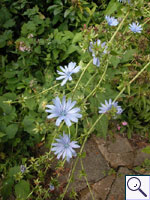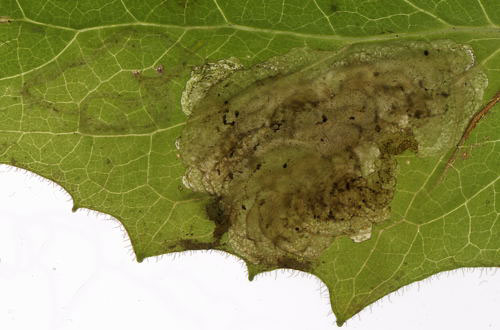|
||||||
|
CICHORIUM. Chicory and Endive. [Asteraceae] |
|
|
Two species of Cichorium are recorded in Britain, the native Chicory (C. intybus) and the introduced Endive (C. endivia). Eight or nine British miners are recorded on Cichorium. A key to the European miners recorded on Cichorium is provided in Bladmineerders van Europa. |
|
Key for the identification of the known mines of British |
||
Note: Diptera larvae may live in a corridor mine, a corridor-blotch mine, or a blotch mine, but never in a case, a rolled or folded leaf, a tentiform mine or sandwiched between two more or less circular leaf sections in later instars. Pupation never in a cocoon. All mining Diptera larvae are leg-less maggots without a head capsule (see examples). They never have thoracic or abdominal legs. They do not have chewing mouthparts, although they do have a characteristic cephalo-pharyngeal skeleton (see examples), usually visible internally through the body wall. The larvae lie on their sides within the mine and use their pick-like mouthparts to feed on plant tissue. In some corridor miners frass may lie in two rows on alternate sides of the mine. In order to vacate the mine the fully grown larva cuts an exit slit, which is usually semi-circular (see Liriomyza huidobrensis video). The pupa is formed within the hardened last larval skin or puparium and as a result sheaths enclosing head appendages, wings and legs are not visible externally (see examples). See Key to non-Diptera. |
||
1a > Leaf-miner: A distinctive mine primarily above mid-rib, with irregular short lateral offshoots into leaf blade. Pupation external (Spencer, 1972: 51 (fig. 172), 55; Spencer, 1976: 270, 271 (fig. 486)). Branched, whitish, upper-surface corridor; main axis overlying the midrib; side branches overlying the main lateral veins. (In Campanula and Phyteuma the mine is much less branched, sometimes nothing more than a corridor on top of the midrib). Frass in rather long strings. Usually the mines begins as a long and narrow, shallow, tortuous lower-surface corridor that ends upon the midrib but otherwise is not associated with the leaf venation. Often this initial corridor is filled with callus, and then even less conspicuous. Pupation outside the mine. A linear mine on the upper surface, usually following the midrib and showing side branches along the veins. The frass is in strings. |
||
|
||
|
||
Liriomyza strigata (Meigen, 1830) [Diptera: Agromyzidae]. |
||
1b > Leaf-miner: Mine not primarily associated with the mid-rib. |
||
2a > Leaf-miner: A small primary blotch, often several larvae feeding together (Spencer, 1972b: 56 (fig. 186); Spencer, 1976: 270, 271 (fig. 483)). Brown, upper-surfsce blotch; often several larvae in a mine. The blotch is preceded by a short initial corridor, often overrun by the later blotch. Frass in a few, small grains. Secondary feeding lines well visible. Pupation outside the mine, exit slit in upper epidermis. Small upper surface blotch, with occasional galleries leading from the blotch. Often several larvae feeding together. |
||
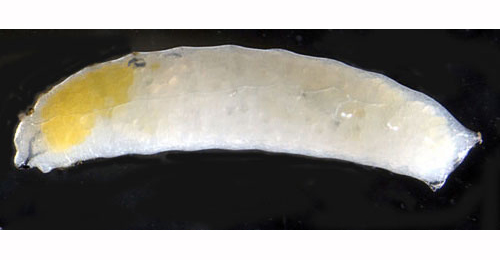 Liriomyza sonchi larva, lateral Image: © Willem Ellis (Bladmineerders van Europa) |
||
|
||
Liriomyza sonchi Hendel, 1931 [Diptera: Agromyzidae]. |
||
2b > Leaf-miner: Mine linear, whitish, both upper and lower surface. Pupation internal, at the end of the mine with the anterior spiracles projecting through the epidermis (Spencer, 1976: 433). Upper-surface, less often lower-surface corridor. Frass in isolated grains. Pupation within the mine, usually in a lower-surface puparial chamber. A long whitish upper surface corridor, which eventually goes lower surface. |
||
|
||
Chromatomyia
horticola (Goureau, 1851) [Diptera: Agromyzidae] |
||
2c > Leaf-miner: The mine begins with a very narrow full depth corridor, that ends upon the midrib. Subsequently a broad corridor, or rather an elongated blotch, is made overlying the midrib; from here broad, lobe-like extensions are made into the blade. Frass in discrete grains. Secondary feeding lines conspicuous. The larva is capable of leaving the mine and restarting in a new leaf, in which case the association with the midrib may be lost. Pupation after vacation of the mine. |
||
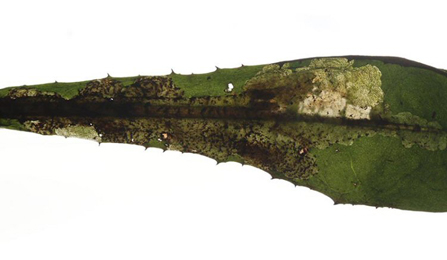 Mine of Trypeta immaculata on Taraxacum Image: Rob Edmunds (British leafminers) |
||
|
||
Trypeta immaculata (Macquart, 1835) [Diptera: Tephritidae]. |
||
2d > Leaf-miner: Egg is laid beneath the epidermis on the upper leaf surface. Larva mines in basal leaves. Pupation internal (Spencer, 1976: 74). Little branched corridors, radiating from the leaf base, often deep in the plant tissue. The larva can migrate from one leaf to the other through the petioles. Frass concentrated in the lowest, basal part of the mine; there also the pupation takes place. |
||
|
||
Ophiomyia pinguis (Fallén, 1820) [Diptera: Agromyzidae]. |
||
2e > Leaf-miner: Larva feeds along the mid-rib, predominantly on the lower surface and there is little evidence of gall-like swelling. Pupation takes place at the base of the midrib (Spencer, 1976: 496). |
||
|
||
Phytomyza continua Hendel, 1920 [Diptera: Agromyzidae]. |
||
2f > Leaf-miner: Elongated upper-surface blotch, preceded by a corridor (exceptionally, visible in the picture, as a long lower-surface corridor). Primary and secondary feeding lines conspicuous. Older mines quickly turn brown. Pupation outside the mine. The mine starts as a corridor which quickly broadens into a blotch, which appears dark with white borders. It is intitially circular or slightly elongated but becomes irregular as the mine matures. The larva is shown and feeding lines are also visible. The mine quickly turns brown and pupation is ouside the mine. The adult was bred and emerged on 10.vii.2017. First discovered in the UK in 2010 (Godfray, 2011). |
||
|
||
|
||
| Liriomyza puella (Meigen, 1830) [Diptera: Agromyzidae] | ||
|
Key for the identification of the known mines of British |
Note: The larvae of mining Coleoptera, Hymenoptera and Lepidoptera may live in a corridor mine, a corridor-blotch mine, a blotch mine, a case, a rolled or folded leaf, a tentiform mine or sandwiched between two more or less circular leaf sections in later instars. Larva may pupate in a silk cocoon. The larva may have six legs (although they may be reduced or absent), a head capsule and chewing mouthparts with opposable mandibles (see video of a gracillarid larva feeding). Larvae of Hymenoptera and Lepidoptera usually also have abdominal legs (see examples). Frass, if present, never in two rows. Unless feeding externally from within a case the larva usually vacates the mine by chewing an exit hole. Pupa with visible head appendages, wings and legs which lie in sheaths (see examples). |
1a > Leaf-miner: In the first instar the larva mines the leaves, forming short, irregular, blotch-like mines, but in later instars it lives externally, feeding in spun leaves and often twisting those of tender shoots. Larval head light-brown or yellowish brown, edged with black postero-laterally, ocellar area blackish; prothoracic plate black edged with whitish anteriorly; abdomen dull dark green; pinacula distinct, black, sometimes brownish but with black bases to setae; anal plate large, black (Bradley et al., 1973). Small, full depth mine without a definite shape; little frass. Some silk is deposited in the mine. The larva soon leaves the mine and continues feeding among spun leaves. |
|
Cnephasia incertana (Treitschke, 1835) [Lepidoptera: Tortricidae]. |
1b > Leaf-miner: The mine begins in the midrib, especially in a lower leaf, extending into the leaf disc, branching irregularly or pinnately, may also locally be blotch like. The mine is brown and very transparent. Sides very irregularly eaten out. Frass loosely dispersed or in a loose central line, buy may also be pressed against the sides of the corridor. The larva may also leave the mine and restart elsewhere. |
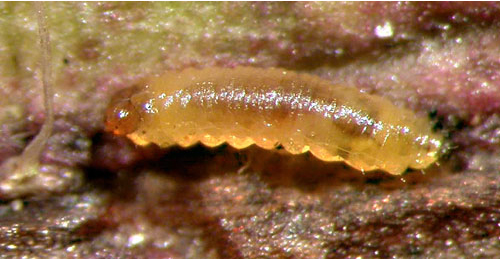 Orthochaetes setiger larva, dorsal Image: © Jean-Yves Baugnée (Bladmineerders van Europa) |
|
Orthochaetes setiger (Beck, 1817) [Coleoptera: Curculionidae]. |
| Last updated 09-Jul-2020 Brian Pitkin | ||

